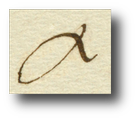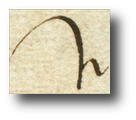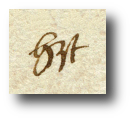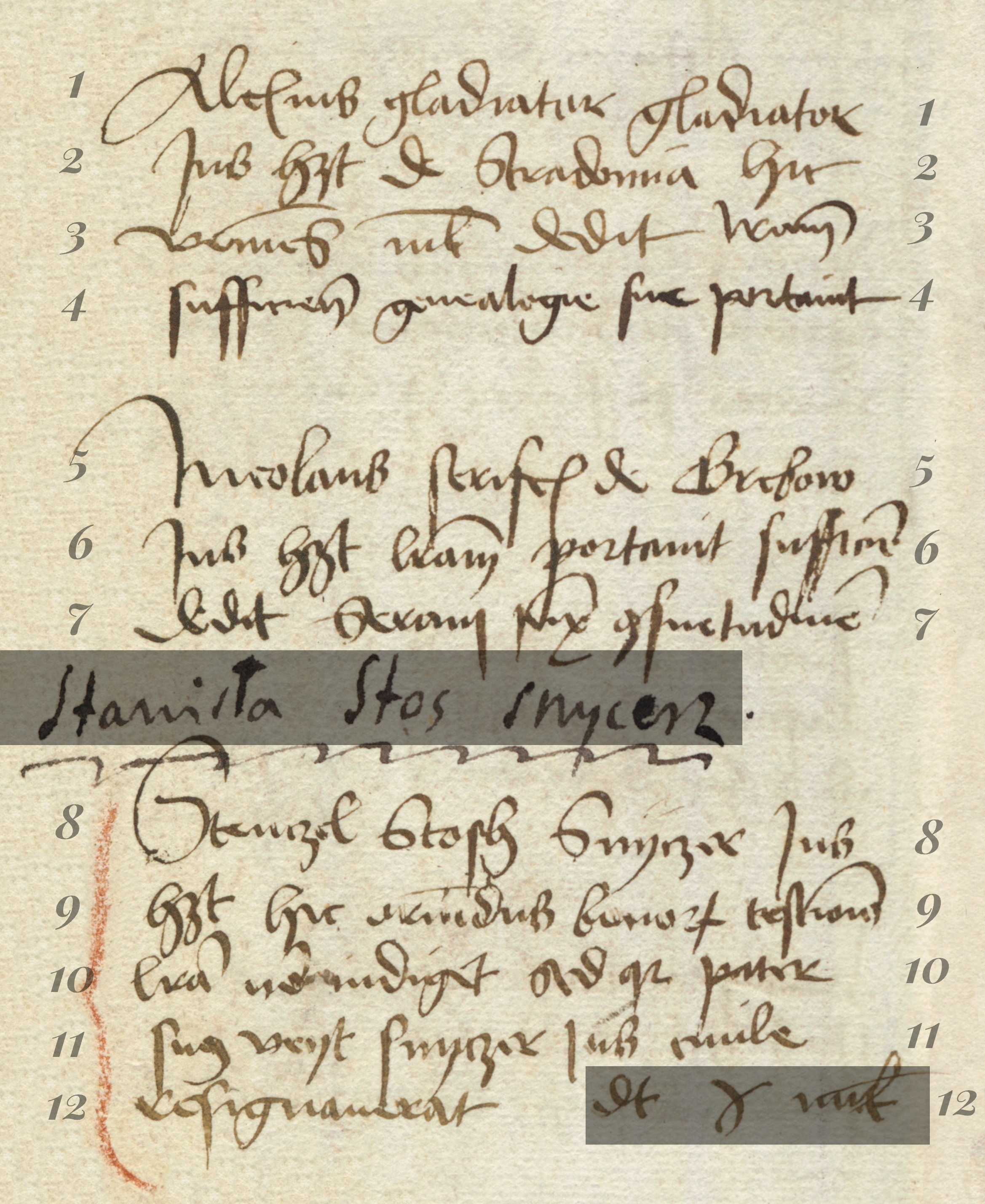Exercise 11
1. Alexius gladiator gladiator
2. Ius habet de Stradomia hic
3. veniens nihil dedit litteram
4. sufficientem genealogie sue portavit
5. Nicolaus serifex de Grebow
6. Ius habet litteram portavit sufficientem
7. dedit seram iuxta consuetudinem
8. Stenczel Stosh Snyczer Ius
9. habet hic oriundus bonorum testimonio
10. littera non indiget sed quia pater
11. suus veyt snyczer Ius civile
12. resignaverat
Principles of transcription
- Maintain the original entry - carry out the transcription as faithfully as possible to the original, without correcting the writer's mistakes.
┬Ā - Lines of text - the transcription should be written in lines (fragments in grey should be omitted). If the word is divided between two lines, it should be written as in the original, that is, without connecting it.
┬Ā - Punctuation - all punctuation marks or others (e.g. commas, full stops, hyphens, etc.) appearing in the original should be ignored.
┬Ā - Writing capital letters - the mechanism recognises both small and capital letters as correct.
┬Ā - Contractions - a contraction used by the writer should be written in full. Do not use square brackets to designate additional letters, complementing the contraction.
┬Ā - The letters u and v - in Latin texts they are often exchanged or written in an identical way. While transcribing, the actual, phonetic sound of the word should be used.
┬Ā - The letter ┼Ė (y with dots or dashes) - should be written as ii (double short i).
┬Ā - The combination of letters qu - we always write as qu.
┬Ā - The letter w - we always write as w.
┬Ā
You can find the full principles of transcription here.
Helpful tips
-
This document contains contractions, however, you have probably noticed that they repeat in the same words which are typical of the contents of this type of entry. In the event of difficulty, you can click on Abbreviations. It is also worth taking a look here in order to read more about the principles of shortening words.
- The scribe wrote the letters c, g, h, l, r, s, t, v and x in various versions. The shape of some letters may be surprising for us today, especially the letters c, k, r, s and x.
┬Ā - The scribe wrote the letter A in an interesting way while opening the entry in the first line.
┬Ā - Remember about how the letter y was written in the past - with one or two dots. This scribe used lines instead of dots.
┬Ā
You will find more useful tips for transcribing old texts here.
Exercise 11
Model letters






































Exercise 11
Abbreviations
![bono[rum]](https://dawnepismo.ank.gov.pl/files/practice/shortcuts/cwiczenie-11/cw11bonorum.png)
![[con]suetudine[m]](https://dawnepismo.ank.gov.pl/files/practice/shortcuts/cwiczenie-11/cw11consuetudinem.png)

![iux[ta]](https://dawnepismo.ank.gov.pl/files/practice/shortcuts/cwiczenie-11/cw11iuxta.png)
![l[itte]ra](https://dawnepismo.ank.gov.pl/files/practice/shortcuts/cwiczenie-11/cw11littera.png)
![l[itte]ram](https://dawnepismo.ank.gov.pl/files/practice/shortcuts/cwiczenie-11/cw11litteram.png)
![ni[hi]l](https://dawnepismo.ank.gov.pl/files/practice/shortcuts/cwiczenie-11/cw11nihil.png)
![no[n]](https://dawnepismo.ank.gov.pl/files/practice/shortcuts/cwiczenie-11/cw11non.png)
![oriu[n]dus](https://dawnepismo.ank.gov.pl/files/practice/shortcuts/cwiczenie-11/cw11oriundus.png)

![suffic[i]e[ntem]](https://dawnepismo.ank.gov.pl/files/practice/shortcuts/cwiczenie-11/cw11sufficientem.png)
![sufficien[tem]](https://dawnepismo.ank.gov.pl/files/practice/shortcuts/cwiczenie-11/cw11sufficientem2.png)
![su[us]](https://dawnepismo.ank.gov.pl/files/practice/shortcuts/cwiczenie-11/cw11suus.png)
![testimo[nio]](https://dawnepismo.ank.gov.pl/files/practice/shortcuts/cwiczenie-11/cw11testimonio.png)
![venie[n]s](https://dawnepismo.ank.gov.pl/files/practice/shortcuts/cwiczenie-11/cw11veniens.png)
